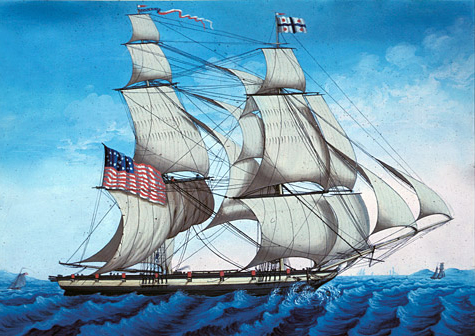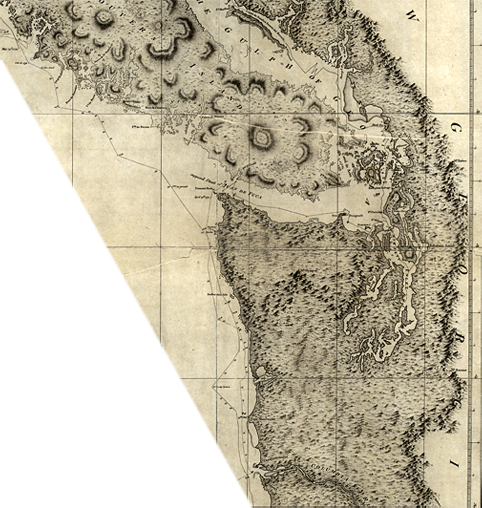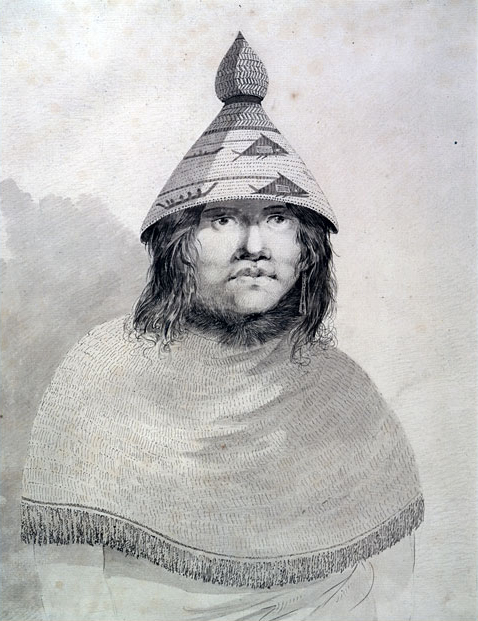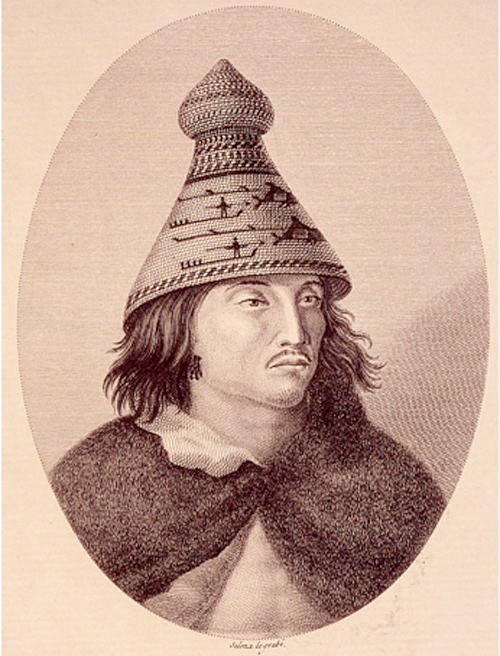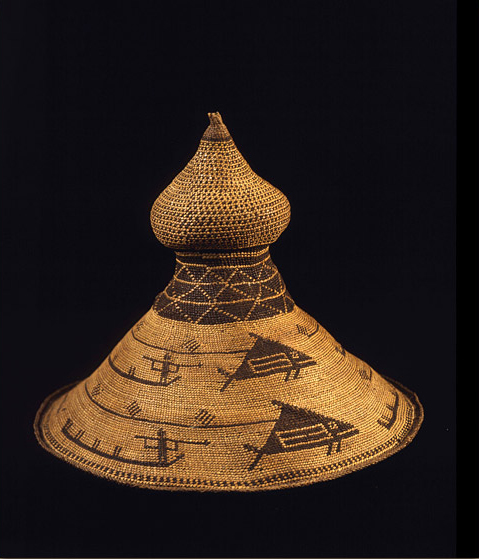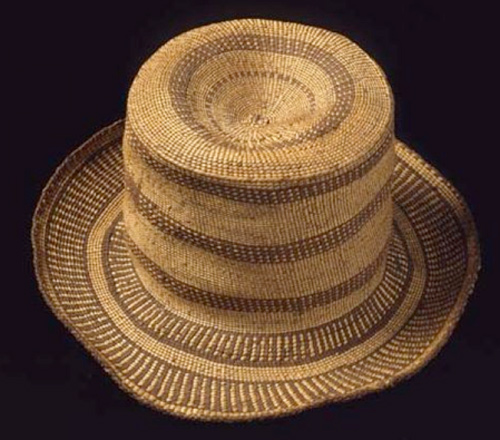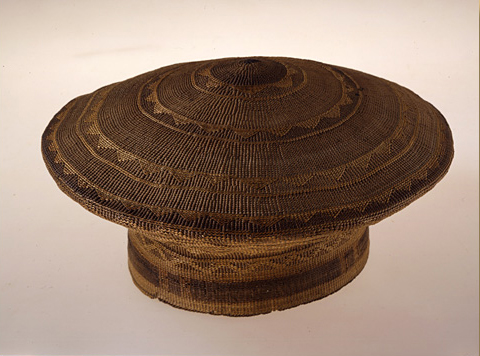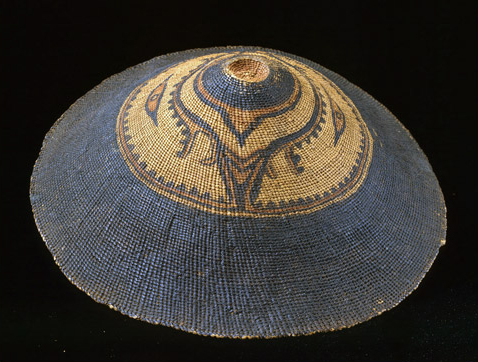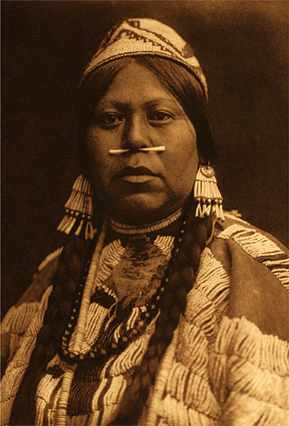Today five Chinookan hats at the Peabody Museum of Archaeology and Ethnology (PMAE) at Harvard University have a provenance that potentially associates them with the Lewis and Clark expedition.
Chinookan Hats for Sale
During the time they spent in the Columbia River, Lewis and Clark observed a number of basketry hats made and worn by the Chinookan-speaking Peoples who lived in the region. The explorers described and illustrated some of these hats in their journals, commissioned others for their own use, and collected hats as souvenirs, which were carefully preserved during the long march back across the continent. Today five hats at the Peabody Museum of Archaeology and Ethnology (PMAE) at Harvard University have a provenance that potentially associates them with the Lewis and Clark expedition.[1]For a complete description of the Lewis and Clark artifacts in the collection of the PMAE, see Castle McLaughlin, Arts of Diplomacy: Lewis and Clark’s Indian Collection. (Seattle: University of … Continue reading
There are several stories woven into the fabric of these hats, and one might look into them for information about the people who made them and used them on the Northwest Coast, the materials from which they are made, the role of women in the manufacturing of practical and ceremonial works of art, the reflection the waterproof hats make on the rainy environment of the Columbia River basin, or the reference on two of them to whale hunting (with all the elaborate technology and ceremony that accompanied the hunt). There is also another story that we can tell using these hats as our evidence, and that is the story of how they got to the Columbia River in the first place, as none of them was made there. This story treats the hats less as cultural items, and more as trade goods.
These hats represent not just the encounter between Lewis and Clark and the people of the Columbia, but an extensive network of trade that existed in the region long before the arrival of the exploring expedition. Not only was there a longstanding history of indigenous trade along the River and its tributaries, but Chinook and Clatsop people had been trading directly with American and European mariners for more than a dozen years, and it is very likely that an American ship conveyed these hats to the Columbia River shortly before the arrival of the Corps of Discovery.
The Trade Network
Figure 2
Vancouver’s Chart of Northwest America (Detail)
To see labels, point to the map.
Library of Congress, Geography and Map Division. Detail from “A Chart shewing part of the Coast of N.W. America with the tracks of His Majesty’s Sloop Discovery and Armed Tender Chatham Commanded by George Vancouver Esq.” (1792-93).
Almost from the moment they entered the Columbia River in late October 1805, Lewis and Clark saw around them abundant evidence of the Americans who had preceded them to the region—Yankee sailors, mostly from Boston (Fig. 1), who were engaged in a trade for furs along the Northwest Coast. The explorers were certainly not surprised by this; the Columbia was named after a Boston ship that had first entered the River in 1792, and Thomas Jefferson had specifically instructed them to look there for an American vessel. “Send two of your trusty people back by sea,” Jefferson wrote, “with a copy of your notes; and should you be of opinion that the return of your party by the way they went will be eminently dangerous, then ship the whole, & return by sea, by the way either of cape Horn, or the cape of good Hope, as you shall be able.”[2]Donald Jackson, ed., Letters of the Lewis and Clark Expedition, with Related Documents, 1783-1854 (Urbana: University of Illinois Press, 1962), 65. William Clark wrote that a number of Chinook and Clatsop people spoke some English, and American and European clothing and trade goods were common among the Native people of the Columbia River. On 20 October 1805, Clark reported the first of many observations of “Salors” clothes being worn by local people.
The tradition of trade along the River influenced the relationship that Lewis and Clark developed with the residents of the region, and it consequently differed substantially from their diplomatic efforts across the rest of the continent. The regular contact that the residents of the Columbia had had with previous parties of Americans and Europeans led to their expectation that the exploring party was there to trade, and that the relationship would be principally mercantile rather than diplomatic. Unlike the Corps of Discovery, American mariners did not have as their principal motive a long-term stable relationship between Americans and Indians. Though owners and managers back in Boston sometimes instructed captains to behave in a way that would promote peaceful repeated visits by other ships, the exigencies of specific situations, and the pressure to make a profit on a voyage, often resulted in fraudulent and coercive behavior on the part of the Americans. Ships regularly sailed away from Northwest Coast Indian villages leaving not only a desire for European goods, but also violence and confusion in their wake.
One of the most notorious of the “Boston Men” on the Northwest Coast was Captain Samuel Hill. William Clark first learned of him from Native people of the Columbia River in the first week of November 1805. Clark was interested in documenting individual American traders by name, if possible, and reported that Captain Hill (called “Haley” by Columbia River Indians) was “the principal man who traded with them.”[3]Gary Moulton, ed., The Journals of the Lewis & Clark Expedition (University of Nebraska Press: 1990), 6:27. Samuel Hill had been in the Columbia River on the Boston brig Lydia for almost a month the previous April and May, and had gone upriver in one of the ship’s boats to “the Great Rapids,” a distance he calculated as 140 miles.[4]Samuel Hill. MS Autobiography dated 14 June 1819. New York Public Library. There he made a number of gifts, including “a Bow of Iron and Several other things” which were later shown to Clark and recorded in the explorer’s journal.[5]Moulton, 6:27 From the Columbia, the Lydia proceeded northwest for more than 600 sea-miles to the Queen Charlotte Islands and then, paralleling the track George Vancouver had followed a dozen years before, sailed some 350 miles southeast to Nootka Sound on the west coast of Vancouver Island (Fig. 2). Captain Hill returned to the Columbia River in November 1805, and it is a good possibility that he brought with him at that time some or all of the basketry hats that are associated with Lewis and Clark today.
Well-traveled Hats
The explorers wrote in their journals about a number of different basketry hats. They drew pictures of one type, with distinctive whaling scenes and a knob on top, purchased others, and even commissioned hats from Clatsop women for their party to wear as rain and sun protection during their homeward journey (1806). Some may have been collected as examples of Indian artisanry, including those that survive today at the PMAE. Of these, two are classic examples of Nuu-chah-nulth (Nootka) whaling hats, one is similar to other Nuu-chah-nulth or Makah hats described as “black-edged” or “black-brimmed,” one is modeled on a European or American top hat, and one is in the shape of a traditional European naval cap. The condition of all five of these hats indicates that a good deal of effort went into their care during transport.
A number of objects were brought east by Lewis and Clark and given to President Thomas Jefferson or to Charles Willson Peale, who founded an important museum in Philadelphia. Castle McLaughlin has written that the kinds of artifacts presented “were largely those . . . which were customarily presented by Native peoples to initiate and formalize social relationships with foreigners,” but that was not the case with these hats acquired in the Columbia. It is very likely that the hats presented (or purchased) by Lewis and Clark were themselves acquired only a short while before in another exchange with Americans. In the case of the top hat and sailor hat, Lewis and Clark knew that they were acquiring evidence of contact and exchange with a previous party of their own countrymen. Clark wrote that the top hat was of a style “common in the U States two years ago.” [6]Moulton, 6:76.
Two of the hats in the Harvard collection are of a type that is unique to the Nuu-chah-nulth (Nootka) whale hunters of the Nootka Sound region and their Makah relations across the Strait of Juan de Fuca on the Northwest tip of Washington State. They were worn by both males and females, and represented the relationship between the role of chief and the role of whaling captain. Though important symbols of rank among the Makah and Nuu-chah-nulth, they were not unavailable to outsiders and a number of them were collected in the late-eighteenth and early-nineteenth centuries.
With their whaling designs and distinctive knobbed peak, these hats were well known to European and American sailors. One such hat was described by Capt. Juan Josef Perez Hernandez, commanding the first Spanish expedition to the Northwest Coast in 1774.[7]Mentioned in a list of artifacts, the “Inventario de las Prendas combalachades con los Yndios.” Quoted in Donald C. Cutter, The California Coast: A Bilingual Edition of Documents from the … Continue reading When the first British ships, under the command of Captain James Cook, arrived at Nootka Sound four years later, a number of these hats were collected.[8]At least six hats were collected on early British expeditions, which are in the collections of the British Museum in London, and museums in Liverpool, Edinburgh and Florence. For more information see … Continue reading The expedition artist John Webber made sketches of men and a woman wearing the hats (Fig. 3), some of which were later engraved and published.[9]James Cook and James King, Voyage to the Pacific Ocean, undertaken by the command of His Majesty, for making discoveries in the northern hemisphere (London, 1784). The original Webber drawing of a … Continue reading Tomas de Suria, a Spanish artist who visited Nootka Sound in 1791, drew the chief at Nootka Sound, Maquinna, wearing one of these hats (Fig. 4), and another Spanish artist, José Cardero, aboard the ship Sutil in 1792, made a portrait of the Makah Chief “Tetacus” or Tatoosh, wearing another.[10]This picture is reproduced in Robin K. Wright, Editor. A Time of Gathering: Native Heritage in Washington State (Seattle: University of Washington Press, 1991), 32.
American mariners donated eight of these whaler’s hats to the Massachusetts Historical Society in Boston in the last decade of the eighteenth century, collected by members of the Columbia crew, and by Captains James Magee and Ebenezer Dorr.[11]All of these hats were subsequently transferred from the MHS to the PMAE; three of them went to other collections in the twentieth century. For details of their history see catalog entry numbers 78, … Continue reading
The Brig Lydia Departs
The active trade at Nootka Sound, including the hat trade, ceased in March 1803, when Chief Maquinna captured and destroyed an American ship, the Boston. It was not until July 1805, when the two survivors of the attack were rescued by Captain Samuel Hill and the crew of the Lydia, that these hats were once again available to American mariners. John Jewitt, one of the two captives rescued by Hill, wrote a book about his experiences in which he describes how Captain Hill took Chief Maquinna hostage to gain his release. Gear from the Boston and numerous other items were transferred to the Lydia during the negotiations, probably including several of the whaler’s hats.
According to Jewitt, four months after the Lydia departed from Nootka Sound on 19 July 1805, the vessel returned to the Columbia River. This means that the two parties of Americans, the Lydia crew and the Lewis and Clark Corps of Discovery, were at the Columbia at the same time. While they never met directly, each party knew of the other, though neither suspected the other was still there or that a rendezvous might be possible. Jewitt wrote that the Lydia “proceeded about ten miles up the river, to a small Indian village, where we heard from the inhabitants, that Captains Clark and Lewis, from the United States of America, had been there about a fortnight before, on their journey overland, and had left several medals with them, which they showed us.”[12]Seth Richards, ed., A Narrative of the Adventures and Sufferings of John R. Jewitt; Only Survivor of the Crew of the Ship Boston, During a Captivity of Nearly 3 Years Among the Savages of Nootka … Continue reading
A Near Miss with the Lydia
Several different Native Americans talked to Lewis and Clark about Captain Samuel Hill as well, from the region of the falls all the way to the mouth of the River. His influence was great enough to inspire the explorers to give the name “Haley’s Bay” to an anchorage near the mouth of the Columbia, in his honor.[13]This bay was called “Baker’s Bay” on George Vancouver’s 1798 chart, and that is the name by which it is still known. Before leaving their winter camp at Fort Clatsop to return east, the explorers compiled a list of a dozen American vessels or captains that were expected by the Indians. Among them was “Mr. Haley,” who was called “the favourite of the Indians (from the number of Presents he gives)” and who had “the trade principaly with all the tribes.”[14]Moulton, 6:155.
Hill had time to distribute a number of hats among the Chinooks and Clatsops during his November stay at the Columbia, and to collect dressed elk hides in exchange, which were desirable among the Haida and Tlingit of the northern coast. In late December 1805, William Clark made a small sketch in his journal of one of the hats collected by his party (Fig. 6). This sketch, which is copied in three other locations in the various manuscript editions of the Lewis and Clark journals, is unmistakably a Nootka Sound whaler’s hat (Fig. 5); the onion-dome shape of the top knob is clearly illustrated.[15]Moulton, 6:141, 144, 247, 250. A month later a more complete description of the hats appears in similar entries of both Lewis and Clark:
The hat at top terminates in a pointed knob of a connic form . . . these hats are made of the bark of cedar and beargrass wrought wih the fingers so closely that it casts the rain most effectually . . . on these hats they work various figures of different colours, but most commonly only black and white are employed. these figures are faint representations of whales the canoes and the harpooneers striking them. Sometimes squares dimonds triangles &c.[16]Moulton, 6:246, 249.
Traditional and Modern Styles
“These figures are faint representations of whales the canoes and the harpooneers striking them.”—Meriwether Lewis
Lewis and Clark imply in their journals that Chinook people were wearing these hats. The two similar hats that were collected by them at that time and which are now in the collection of the PMAE, however, are in such excellent condition that they cannot have been worn for long before they were acquired. Of the other three surviving hats, one is of a traditional style found in northwestern Washington State (Fig. 7), one is in the shape of a top hat (Fig. 8), and one is in the shape of a European sailor’s hat (Fig. 9).
The form of the top hat was instantly recognized by Lewis and Clark. Clark wrote on 21 November 1805 that he “purchased a hat made of Splits & Strong grass, which is made in the fashion which was common in the U States two years ago.”[17]Moulton, 6:76. On 19 January 1806 he and Lewis once again entered near-identical descriptions of the hats in their journals: “The form of the Hats is that which was in voge in the Ustates and Great Britain in 1800 & 1801 with a high Crown rather larger at the top than where it joins the brim, the brim narrow about 2 or 2½ inches.”[18]Moulton, 6:221, 222.
The explorers would also have recognized the basketry sailor hat, which had been incorporated into the Columbia wardrobe along with the other sailor clothes purchased from visiting Americans. European naval sailors of the 18th century wore a distinctive hat with a narrow band across the forehead (usually with a ribbon identifying the name of the sailor’s ship) and a wide crown. Native Alaskans reproduced the shape of these hats in sea mammal intestines and a number survive.[19]Bill Holm and Thomas Vaughan, Soft Gold: The Fur Trade and Cultural Exchange on the Northwest Coast of America (Portland: Oregon 1990), 39. This basketry example is the only one known.
The style of decoration and the construction techniques of the top hat and sailor hat indicate that they were not made by a Clatsop or Chinook artist, as Lewis and Clark thought. They were more likely the product of Haida or Tlingit artists, from several hundred miles north in the Queen Charlotte Islands of British Columbia and the adjacent coast of Alaska.[20]For several examples, see Varjola Pirjo, Julia Averkieva and Rosa Liapunova, The Etholén Collection: The Ethnographic Alaskan Collection of Adolf Etholén and his Contermporaries in the National … Continue reading Samuel Hill had traded extensively in that region before his return to the Columbia in November 1805, and he may have brought these hats with him.
Lewis and Clark could not have known the exact origin of the hats they bought, or distinguished between the stylistic characteristics that identified some as originating further north from those made by local women. They describe purchasing hats on several occasions, most of which were the product of local handiwork, and they observed that basketry hats formed “a small article of traffic with the Clatsops and Chinnooks who dispose of them to the whites.”[21]Moulton, 6:221. Over the next few decades basketry hats became increasingly important as trade items. By 1814, Chinook hats were being traded by the caseload from the trading post at Astoria,[22]“Bill Of Lading Of 10 Canoes From Fort George, Apr. 4th. 1814,” in Elliott Coues, ed., New Light on the Early History of the Greater Northwest: The Manuscript Journals of Alexander Henry … Continue reading and ten years after that trader George Simpson was describing them as the standard item against which the value of other goods was measured.[23]Frederick Merk, ed., Fur Trade and Empire; George Simpson’s Journal . . . 1824-1825 (Cambridge: Harvard University Press, 1931), 171. Unfortunately, despite the fact that Chinook and Clatsop hats were universally admired by travelers of the early nineteenth century, and were traded in large numbers, no examples or images survive to show us what they looked like. That makes the most common hats purchased by Lewis and Clark the most tantalizing.
Lost Hats
Nuu-chah-nulth or Makah black-edged hat collected by Lewis and Clark at the Columbia River.
Figure 11
Wishram Woman with Cap
Edward S. Curtis (1868–1952)
Archives and Special Collections, Mansfield Library, The University of Montana, Missoula. E.S. Curtis, The North American Indian, Vol 8, p. 130 (1910).
Wishram woman wearing a cap similar to the “Cap, worn by the women of the Plains of Columbia,” collected by Lewis and Clark.
While the hats at the PMAE, including the two whaler’s hats, were carefully preserved for the trip back to St. Louis and then Washington, a number of other hats were ordered by the Lewis and Clark party for their own use. On 22 February 1806, Lewis wrote:
We were visited today by two Clatsop women and two boys who brought a parsel of excellent hats made of Cedar bark and ornamented with beargrass. two of these hats had been made by measures which Capt Clark and myself had given one of the women some time since with a request to make each of us a hat; they fit us very well, and are in the form we desired them. we purchased all their hats and distributed them among the party.[24]Moulton, 6:335, 337.
Meriwether Lewis gives us only one brief hint of one of the Clatsop/Chinook hats, and then only after it had been totally used up and was in pieces. On 7 August 1806 near the Yellowstone River, while looking to rendezvous with Clark’s party, one of his men went ashore and “found at this place a part of a Chinook hat, which my men recognized as the hat of Gibson.”[25]Moulton, 8:151. The fact that it was recognizable as belonging to a specific individual suggests that it was not one of the whaler’s hats, which were all of a similar design.
Alexander Ross, who lived at Astoria, the first American trading post on the Columbia, described a Chinook hat in 1811 as “made of a tough strong kind of grass, and of so close a texture as to be water-proof,” which would have made it an excellent choice for the Corps of Discovery. Ross says the hat was pointed at the top, and the rim was “so very broad as to screen the shoulders from the rain.” Most importantly, he tells us that these hats were “chequered or diversified with the rude figures of different animals, particularly the dog and dear, not painted, but ingeniously interwoven.”[26]Alexander Ross, Adventures of the First Settlers on the Oregon or Columbia River, 1810-1813 (Cleveland: A.H. Clark, 1904), 104. An ancient hat, between 400 and 1000 years old, which was excavated near Tacoma, Washington in 1976, has a shape that fits Ross’s description. Chinook hats may also have been similar in shape to the “black-rimmed” hat collected by Lewis and Clark (Fig. 10, though that specific example, like the whaler’s hats, was probably made at Nootka Sound.[27]Robin Wright in A Time of Gathering: Native Heritage in Washington State (Seattle: University of Washington Press, 1991) says that “a simpler domed hat with no knob on the top was common … Continue reading
Lewis and Clark almost certainly also collected a hat, which sadly does not survive, from the Wasco or Wishram people, Chinookan speakers who live well upstream. On 1 November 1805, while still in the area of the falls of the Columbia, Clark wrote that local people in the area “Sold me a hat of their own taste and baskets in which they hold their water.”[28]A wonderful Wasco basket, woven so tightly that it might have been thought a water basket, is in the PMAE collection and also associated with Lewis and Clark. See McLaughlin, 275-287. For more … Continue reading The incomplete memorandum of material that was received by the Peale Museum from the Corps of Discovery includes a “Cap, worn by the women of the Plains of Columbia,”[29]McLaughlin, 71. differentiating it from the two other hats in the list, which specify a collecting location “near the Pacific Ocian.” This was probably a Wasco/Wishram hat (Fig. 11) of the sort documented since the late eighteenth century and still made and worn today. A member of the Vancouver expedition collected a similar hat in 1792, which is in the collection of the British Museum.[30]Wright, 41.
A Letter for Captain Hill
On 18 March 1806, Meriwether Lewis and William Clark gave a letter to the Chinook Chief Delashelwilt to be delivered to the captain of the next ship that came into the River, which turned out once again to be Samuel Hill on the Lydia. Hats in hand, the explorers turned east for the long trek back. By 1810 a number of them were in the collection of the Peale Museum in Philadelphia. Over time, collections from the Peale Museum were sold to the Boston Museum and eventually transferred to the PMAE at Harvard.
Captain Hill and the Lydia returned one more time to the Columbia River before setting sail for Canton and home. On 15 July 1806 William Walker, Captain Hill’s clerk, wrote in his journal that “the Natives returned a paper on board that Capt. Clark Had left with them declaring them citizens of America they tell us he Left them in April. He says the Natives here have treated him verry Civil on his travels through.”[31]MS. Journal of William Walker, Brig Lydia of Boston, 1805-1807. Western Americana Collection, WA MSS S-214, Beinecke Library, Yale University. Hill carried the letter on to Canton where it was put on a Philadelphia vessel bound home via the Cape of Good Hope.
We are fortunate that so many documents survive to tell us about the interaction of the Native people of the Columbia River with Meriwether Lewis, William Clark, and Samuel Hill. The journals kept by members of the Corps of Discovery and members of the ship’s crew are the obvious ones, but these five hats make the links of trade tangible. Durable and portable, the basketry hats of Northwest Coast Indian people were desirable for their usefulness and as souvenirs of travel. Beautifully designed and made, they continue to inspire and inform us.
See also Clatsop Cone Hats.
Bibliography:
Coues, Elliott, ed., New Light on the Early History of the Greater Northwest: The Manuscript Journals of Alexander Henry and David Thompson, 1799-1814. New York: Harper, 1897.
Cutter, Donald C., The California Coast: A Bilingual Edition of Documents from the Sutro Collection. Norman: University of Oklahoma Press, 1969.
Jackson, Donald, ed., Letters of the Lewis and Clark Expedition, with Related Documents, 1783-1854. Urbana: University of Illinois Press, 1962.
Jewitt, John. A Narrative of the Adventures and Sufferings of John R. Jewitt; Only Survivor of the Crew of the Ship Boston, During a Captivity of Nearly 3 Years Among the Savages of Nootka Sound, with an Account of the Manners, Mode of Living, and Religious Opinions of the Natives. Middletown, Connecticut, 1815.
Kaeppler, Adrienne L. “Artificial Curiosities” Being an Exposition of Native Manufactures Collected on the Three Pacific Voyages of Captain Cook, R.N. Honolulu: Bishop Museum, 1985.
King, J.C.H. Artificial Curiosities from the Northwest Coast of America: Native American Artefacts in the British Museum Collected on the Third Voyage of Captain James Cook and Acquired through Sir Joseph Banks. London: British Museum Publications, 1981.
Malloy, Mary. “Boston Men” on the Northwest Coast: The American Maritime Fur Trade, 1788-1844. Fairbanks: Limestone Press, University of Alaska, 1998.
______, Devil on the Deep Blue Sea: The Notorious Career of Captain Samuel Hill of Boston. Jersey Shore, Pennsylvania: Bullbrier Press, 1006.
______, Souvenirs of the Fur Trade: Northwest Coast Indian Art and Artifacts Collected by American Mariners. Cambridge: Peabody Museum, Harvard University, 2000.
McLaughlin, Castle. Arts of Diplomacy: Lewis and Clark’s Indian Collection. Seattle: University of Washington Press, 2003.
Moulton, Gary, ed. The Journals of the Lewis & Clark Expedition, Vol. 6: 2 November 1805–22 March 1806. University of Nebraska Press: 1990.
Ross, Alexander. Adventures of the First Settlers on the Oregon or Columbia River, 1810-1813. Cleveland: A.H. Clark, 1904.
Schlick, Mary Dodds. Columbia River Basketry: Gift of the Ancestors, Gift of the Earth. Seattle: University of Washington Press, 1994.
Silverstein, Michael. “Chinnookans of the Lower Columbia,” Handbook of North American Indians, Vol. 7, Northwest Coast, Wayne Suttles, ed. Washington, D.C.: Smithsonian Institution, 1990, 533-546.
Vaughan, Thomas and Bill Holm. Soft Gold: The Fur Trade and Cultural Exchange on the Northwest Coast of America. Portland: Oregon Historical Society, 1990.
Wright, Robin K., ed. A Time of Gathering: Native Heritage in Washington State. Seattle: University of Washington Press, 1991.
Notes
| ↑1 | For a complete description of the Lewis and Clark artifacts in the collection of the PMAE, see Castle McLaughlin, Arts of Diplomacy: Lewis and Clark’s Indian Collection. (Seattle: University of Washington Press, 2003). |
|---|---|
| ↑2 | Donald Jackson, ed., Letters of the Lewis and Clark Expedition, with Related Documents, 1783-1854 (Urbana: University of Illinois Press, 1962), 65. |
| ↑3 | Gary Moulton, ed., The Journals of the Lewis & Clark Expedition (University of Nebraska Press: 1990), 6:27. |
| ↑4 | Samuel Hill. MS Autobiography dated 14 June 1819. New York Public Library. |
| ↑5 | Moulton, 6:27 |
| ↑6 | Moulton, 6:76. |
| ↑7 | Mentioned in a list of artifacts, the “Inventario de las Prendas combalachades con los Yndios.” Quoted in Donald C. Cutter, The California Coast: A Bilingual Edition of Documents from the Sutro Collection (Norman: University of Oklahoma Press, 1969), 278. |
| ↑8 | At least six hats were collected on early British expeditions, which are in the collections of the British Museum in London, and museums in Liverpool, Edinburgh and Florence. For more information see J.C.H. King, Artificial Curiosities from the Northwest Coast of America (London: British Museum Publications, 1981); and Adrienne Kaeppler, “Artificial Curiosities” Being an Exposition of Native Manufactures Collected on the Three Pacific Voyages of Captain Cook, R.N. (Honolulu: Bishop Museum, 1985). |
| ↑9 | James Cook and James King, Voyage to the Pacific Ocean, undertaken by the command of His Majesty, for making discoveries in the northern hemisphere (London, 1784). The original Webber drawing of a “Woman of Nootka Sound,” is in the collection of the PMAE. |
| ↑10 | This picture is reproduced in Robin K. Wright, Editor. A Time of Gathering: Native Heritage in Washington State (Seattle: University of Washington Press, 1991), 32. |
| ↑11 | All of these hats were subsequently transferred from the MHS to the PMAE; three of them went to other collections in the twentieth century. For details of their history see catalog entry numbers 78, 82F and 92D in Mary Malloy, Souvenirs of the Fur Trade: Northwest Coast Indian Art and Artifacts Collected by American Mariners (Cambridge: Peabody Museum, Harvard University, 2000). |
| ↑12 | Seth Richards, ed., A Narrative of the Adventures and Sufferings of John R. Jewitt; Only Survivor of the Crew of the Ship Boston, During a Captivity of Nearly 3 Years Among the Savages of Nootka Sound, 2d ed. (Middletown, Connecticut, 1815). |
| ↑13 | This bay was called “Baker’s Bay” on George Vancouver’s 1798 chart, and that is the name by which it is still known. |
| ↑14 | Moulton, 6:155. |
| ↑15 | Moulton, 6:141, 144, 247, 250. |
| ↑16 | Moulton, 6:246, 249. |
| ↑17 | Moulton, 6:76. |
| ↑18 | Moulton, 6:221, 222. |
| ↑19 | Bill Holm and Thomas Vaughan, Soft Gold: The Fur Trade and Cultural Exchange on the Northwest Coast of America (Portland: Oregon 1990), 39. |
| ↑20 | For several examples, see Varjola Pirjo, Julia Averkieva and Rosa Liapunova, The Etholén Collection: The Ethnographic Alaskan Collection of Adolf Etholén and his Contermporaries in the National Museum of Finland (Helsinki: Museuvirasto, 1991). |
| ↑21 | Moulton, 6:221. |
| ↑22 | “Bill Of Lading Of 10 Canoes From Fort George, Apr. 4th. 1814,” in Elliott Coues, ed., New Light on the Early History of the Greater Northwest: The Manuscript Journals of Alexander Henry and David Thompson, 1799-1814 (New York: Harper, 1897), vol. II, p. 876. |
| ↑23 | Frederick Merk, ed., Fur Trade and Empire; George Simpson’s Journal . . . 1824-1825 (Cambridge: Harvard University Press, 1931), 171. |
| ↑24 | Moulton, 6:335, 337. |
| ↑25 | Moulton, 8:151. |
| ↑26 | Alexander Ross, Adventures of the First Settlers on the Oregon or Columbia River, 1810-1813 (Cleveland: A.H. Clark, 1904), 104. |
| ↑27 | Robin Wright in A Time of Gathering: Native Heritage in Washington State (Seattle: University of Washington Press, 1991) says that “a simpler domed hat with no knob on the top was common throughout western Washington,” though “all well-documented hats” like the black-brimmed example “come either from the Nuu-chah-nulth on the west coast of Vancouver Island or from the Makah at Neah Bay.” (40-41) Wright illustrates the hat excavated near Tacoma, along with a re-creation of it by the Chinook/Puyallup weaver Karen Reed-Peter, which is also available on the Burke Museum website at http://www.washington.edu/burkemuseum/baskets/artists/archy.html. |
| ↑28 | A wonderful Wasco basket, woven so tightly that it might have been thought a water basket, is in the PMAE collection and also associated with Lewis and Clark. See McLaughlin, 275-287. For more information on Wasco/Wishram hats, see Mary Dodds Schlick, Columbia River Basketry: Gift of the Ancestors, Gift of the Earth (Seattle: University of Washington Press, 1994). |
| ↑29 | McLaughlin, 71. |
| ↑30 | Wright, 41. |
| ↑31 | MS. Journal of William Walker, Brig Lydia of Boston, 1805-1807. Western Americana Collection, WA MSS S-214, Beinecke Library, Yale University. |
Experience the Lewis and Clark Trail
The Lewis and Clark Trail Experience—our sister site at lewisandclark.travel—connects the world to people and places on the Lewis and Clark Trail.
Discover More
- The Lewis and Clark Expedition: Day by Day by Gary E. Moulton (University of Nebraska Press, 2018). The story in prose, 14 May 1804–23 September 1806.
- The Lewis and Clark Journals: An American Epic of Discovery (abridged) by Gary E. Moulton (University of Nebraska Press, 2003). Selected journal excerpts, 14 May 1804–23 September 1806.
- The Lewis and Clark Journals. by Gary E. Moulton (University of Nebraska Press, 1983–2001). The complete story in 13 volumes.
